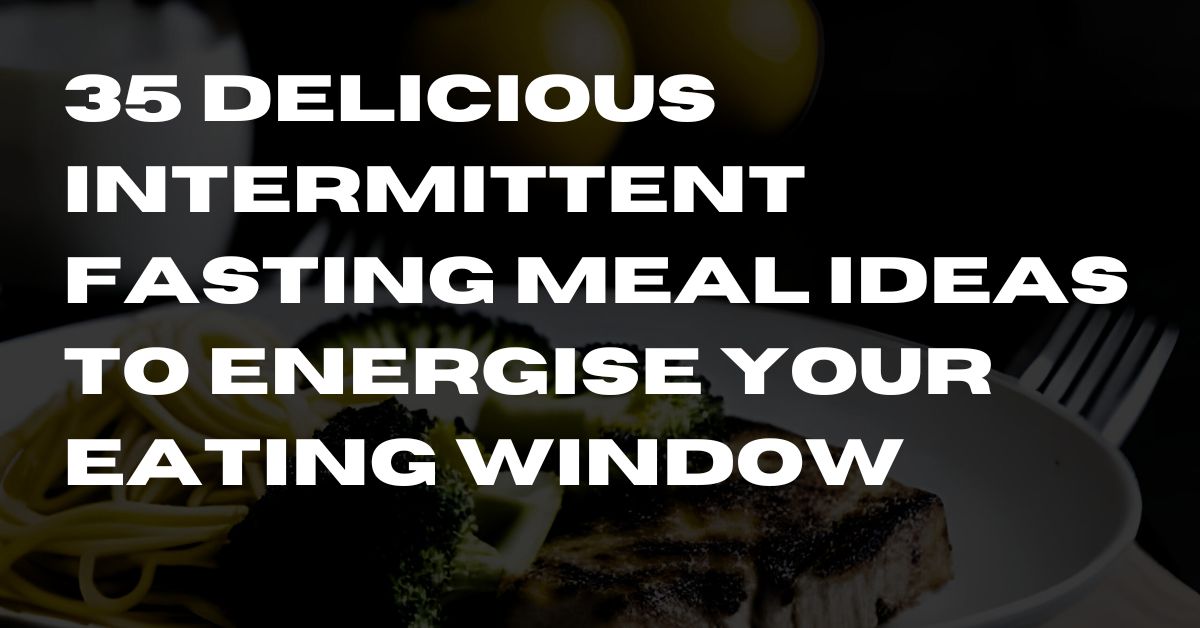In recent years, intermittent fasting has surged in popularity, garnering widespread attention as a compelling approach to both weight loss and overall health improvement.
By embracing a rhythmic pattern of eating and fasting, this dietary practice is believed to enhance the body’s natural fat-burning capabilities, while also offering an array of potential health benefits.
From supporting cellular repair and reducing inflammation to optimising insulin sensitivity, intermittent fasting has captured the interest of health-conscious individuals worldwide.
However, amidst the growing enthusiasm for this eating pattern, some individuals have encountered difficulties in devising meal ideas that align seamlessly with their fasting schedules.
In this article, we aim to delve into the realm of culinary creativity and present a delectable array of intermittent fasting meal ideas, carefully crafted to satiate your taste buds and make your fasting journey not only fruitful but thoroughly enjoyable.
From nutritious and satisfying dishes to smart snacking options, we will explore an array of delightful recipes that complement various fasting protocols, making your path to wellness and enticing and flavoursome adventure.
Whether you are a seasoned intermittent faster or just embarking on this health-conscious voyage, let these meal ideas serve as your culinary compass, guiding you toward a balanced and fulfilling eating experience during your fasting windows.
Let’s embark on this gastronomic journey together, discovering the delicious potential that intermittent fasting has to offer.
What is Intermittent Fasting?
Intermittent fasting is not just another diet; it’s a way of eating that has been practiced by humans for centuries. In simple terms, it’s an eating pattern that involves alternating periods of eating and fasting. Unlike conventional diets that focus on what you can and cannot eat, intermittent fasting is more about when you eat.
Think of it as a return to our ancestral roots when food wasn’t available 24/7, and our bodies evolved to function optimally during periods of both feast and famine. Our ancestors would have experienced natural cycles of food availability, and their bodies adapted to thrive under these conditions (*).
With intermittent fasting, you don’t necessarily have to restrict the types of foods you eat, though it’s essential to make nutritious choices during your eating windows. Instead, you concentrate on narrowing down the time window in which you consume your meals (*).
There are various methods of intermittent fasting, but one of the most common and popular approaches is the 16/8 method. In this method, you fast for 16 hours and eat during an 8-hour window.
For example, you might skip breakfast and start eating at noon, then finish your last meal by 8 pm, after which you fast until noon the next day.
The beauty of intermittent fasting is its flexibility. You can adjust the eating and fasting periods to fit your schedule and lifestyle.
Some people find it easier to fast in the morning and eat their meals later in the day, while others prefer an early dinner and a longer fasting period overnight.
But what’s the point of fasting? Well, during fasting periods, your body taps into its stored energy reserves, breaking down fats to provide the fuel it needs.
This can lead to weight loss, improved metabolic health, and even potential benefits for brain function and longevity.
Moreover, intermittent fasting may help improve our relationship with food. It encourages mindful eating and being in tune with your body’s hunger cues.
Instead of constantly grazing on snacks and meals throughout the day, intermittent fasting allows your digestive system to rest and reset, giving your body a chance to repair and regenerate.
Benefits of Intermittent Fasting
Weight Loss
If you’ve been on a weight loss journey, you know how challenging it can be to shed those extra pounds. Intermittent fasting offers a refreshing approach that not only helps you lose weight but also provides numerous other health benefits.
Picture this: you wake up, and instead of rushing to prepare breakfast, you take a moment to savor a cup of black coffee or herbal tea. You’re practicing intermittent fasting, a way of eating that focuses on when you eat rather than what you eat.
During the fasting period, which typically lasts for 16 hours, your body goes into fat-burning mode.
One of the most significant advantages of intermittent fasting is its potential to jumpstart your weight loss efforts. By restricting you’re eating window, you naturally reduce your calorie intake, leading to a calorie deficit (*). This deficit compels your body to use stored fat as an energy source, melting away those stubborn pounds over time.
But the benefits don’t end there. Intermittent fasting has shown promise in improving metabolic health. It can increase insulin sensitivity, which helps regulate blood sugar levels and reduces the risk of type 2 diabetes.
By giving your digestive system regular breaks, you also promote better digestion and gut health, which are vital for overall well-being.
Intermittent fasting is flexible and can easily fit into your daily routine. You don’t have to meticulously plan out every meal or cut out your favorite foods completely. Instead, you learn to be more mindful of your eating habits and make healthier choices during your eating windows.
Improved Metabolic Health
Intermittent fasting offers a powerful advantage that many are seeking: improved metabolic health. In real-life terms, this means unlocking your body’s potential to function more efficiently, like a well-oiled machine.
Our metabolism is the engine that drives the way our bodies convert food into energy. When our metabolism is functioning optimally, we can maintain a healthy weight, keep our blood sugar levels stable, and even reduce the risk of chronic diseases.
Intermittent fasting works its magic by giving our metabolism a chance to reset and recalibrate (*). During fasting periods, when we’re not consuming any calories, our body turns to its stored energy reserves for fuel.
This process encourages the breakdown of fats and stimulates weight loss, especially when combined with a balanced diet.
By restricting our eating window and providing our digestive system with regular breaks, intermittent fasting also helps regulate insulin levels. Insulin is a hormone responsible for managing blood sugar levels.
When our body becomes more insulin-sensitive, it can use glucose (sugar) from the bloodstream more effectively, reducing the risk of insulin resistance and type 2 diabetes.
Intermittent fasting may also lead to increased levels of human growth hormone (HGH). HGH plays a vital role in metabolism, helping to maintain muscle mass, promote fat burning, and support overall cellular repair (*).
What does this mean for you in everyday life? Improved metabolic health can translate into more energy throughout the day. You’ll likely experience fewer energy crashes and sugar cravings. It may also make it easier to maintain or achieve a healthy weight, supporting your overall well-being and self-confidence.
Beyond the physical benefits, improved metabolic health can positively impact your mental clarity and focus. By stabilising blood sugar levels, you can experience more sustained cognitive performance, allowing you to be sharper and more productive during work or study hours.
Cellular Repair and Autophagy
Intermittent fasting isn’t just about weight management; it offers a range of fascinating benefits that go beyond the scale. One of the most intriguing advantages is its impact on cellular repair and a natural process called autophagy.
1. Cellular Repair: Rejuvenating Your Body at the Cellular Level
Our bodies are made up of trillions of cells, each with its specific role. Over time, these cells can become damaged or worn out, leading to reduced functionality. Here’s where intermittent fasting comes to the rescue.
During fasting periods, when you’re not consuming calories, your body switches gears to focus on repair and maintenance (*). It’s like a power-saving mode for your cells, allowing them to channel energy into essential repair processes.
Research suggests that intermittent fasting enhances the expression of genes responsible for cell repair and stress resistance (*). As a result, your cells become more efficient, and their overall performance improves. This, in turn, can promote better tissue function and contribute to your overall health.
2. Autophagy: Your Body’s Cleanup Crew
Autophagy, often referred to as the body’s cleanup crew, is a fascinating biological process. It’s your cells’ way of getting rid of damaged components, like misfolded proteins and malfunctioning organelles.
Think of it as a thorough spring cleaning for your cells. Autophagy engulfs these damaged parts and breaks them down into their basic building blocks, which your cells can then reuse to build newer and healthier components (*).
Intermittent fasting has been shown to stimulate autophagy, promoting a more efficient cellular cleanup process (*). By encouraging this natural recycling, your body can effectively dispose of dysfunctional cellular components and rejuvenate itself.
3. Real-Life Connection: Repairing and Rejuvenating Like a Master Craftsman
Imagine your body as a well-crafted masterpiece, intricately designed to function at its best. However, just like any work of art, it requires regular maintenance and repairs to retain its brilliance.
Intermittent fasting acts as a master craftsman, diligently restoring your body’s intricate cellular machinery. By allowing your cells to take a break from constant digestion, they shift their focus to refurbishing and optimising their internal structure.
Autophagy, the body’s cleanup crew, steps in to remove the clutter and damaged parts that accumulate over time. This process ensures that your cellular masterpiece remains vibrant and efficient, contributing to your overall well-being.
Reduced Inflammation
Incorporating intermittent fasting into your lifestyle can do more than just aid in weight management and support overall health. One of the significant benefits that many people experience is reduced inflammation throughout the body.
Inflammation is a natural immune response that helps our bodies fight off infections and heal injuries. However, chronic inflammation can be harmful, leading to various health issues like arthritis, heart disease, and even certain types of cancer. By adopting intermittent fasting, you can help keep inflammation in check, promoting a healthier and more resilient body.
Intermittent fasting encourages the body to enter a state of metabolic switching, where it transitions from using glucose as its primary energy source to burning stored fats (*). During fasting periods, the body produces ketones, which have been shown to have anti-inflammatory properties.
Moreover, intermittent fasting helps regulate insulin levels, which can play a crucial role in reducing inflammation. When we consume food, especially those high in refined sugars and carbohydrates, our blood sugar levels spike, leading to increased insulin release (*).
Over time, this can lead to insulin resistance and chronic inflammation. By giving your body extended periods of rest from food, intermittent fasting helps improve insulin sensitivity, reducing inflammation and supporting overall metabolic health.
Real-life stories of individuals who have adopted intermittent fasting often reveal significant improvements in inflammatory conditions like joint pain, skin issues, and digestive problems. Many people find that by giving their bodies the chance to rest and repair during fasting periods, they experience a decrease in symptoms related to inflammation.
Better Brain Health
Intermittent fasting offers more than just a way to shed a few pounds; it has the potential to supercharge your brain health too! The benefits extend beyond the waistline and can help you achieve a sharper and more focused mind.
- Enhanced Brain Function: When you fast, your body enters a state of mild stress, triggering the production of neurotrophic factors in the brain. These compounds support the growth of new neurons and strengthen existing connections, leading to improved cognitive function and enhanced learning capabilities.
- Reduced Risk of Neurodegenerative Diseases: Studies suggest that intermittent fasting may reduce the risk of neurodegenerative disorders like Alzheimer’s and Parkinson’s disease (*). By promoting autophagy, a process that removes damaged cells and proteins, fasting helps protect the brain from harmful substances that can contribute to these conditions.
- Increased Brain-Derived Neurotrophic Factor (BDNF): Intermittent fasting stimulates the production of BDNF, a protein that supports the survival of nerve cells and plays a vital role in memory, learning, and overall brain health (*). Higher levels of BDNF are associated with improved cognitive function and a reduced risk of mental decline.
- Enhanced Focus and Mental Clarity: During fasting periods, the body relies on ketones as an alternative energy source. Ketones provide a steady supply of fuel to the brain, promoting mental clarity and focus, making it easier to concentrate on tasks, and boosting productivity.
- Regulated Blood Sugar Levels: Intermittent fasting can help stabilize blood sugar levels, reducing the risk of insulin resistance. This balance is essential for brain health, as excessive insulin levels can lead to inflammation and impair cognitive abilities.
Tips for Successful Intermittent Fasting
Stay Hydrated
Embarking on an intermittent fasting journey can bring a multitude of health benefits, but it’s crucial to stay hydrated throughout the process. As you navigate your fasting and eating windows, here are some real-life connecting tips to keep you hydrated and make the most of your intermittent fasting experience:
- Water is Your Best Friend: During fasting periods, water becomes your ultimate ally. It’s calorie-free and helps quench your thirst without breaking your fast. Keep a water bottle within arm’s reach to sip throughout the day, ensuring you stay hydrated and support your body’s natural detoxification processes.
- Add Some Flavor: If plain water doesn’t excite your taste buds, infuse it with natural flavors. Try adding slices of lemon, cucumber, or a few water juices for a refreshing twist. These additions not only enhance the taste but also provide a slight boost of vitamins and antioxidants.
- Stay Mindful of Caffeine: Coffee and tea lovers, rejoice! Moderate consumption of black coffee and herbal teas without sweeteners or cream can be enjoyed during fasting periods. Not only can they help curb hunger pangs, but they also provide a gentle energy boost to keep you focused.
- Avoid Sugary Beverages: Stay away from sugary sodas, fruit juices, and energy drinks, as they can spike your insulin levels and break your fast. Opt for healthier alternatives that won’t interfere with the benefits of intermittent fasting.
- Electrolytes are Essential: When fasting for extended periods, especially in hot weather or during intense physical activities, it’s vital to maintain electrolyte balance. Low-calorie electrolyte drinks or electrolyte-infused water can help replenish these essential minerals lost through sweat.
Eat Balanced Meals
- Prioritize Protein: During your eating windows, make sure to include a good source of protein in each meal. Protein not only helps with muscle maintenance but also keeps you feeling full and satisfied. Opt for lean proteins like chicken, fish, tofu, or legumes to support your body’s needs.
- Embrace Healthy Fats: Don’t shy away from fats but choose the healthy ones. Incorporate avocados, nuts, seeds, and olive oil into your meals. Healthy fats provide a steady source of energy and are essential for various bodily functions, including brain health.
- Include Complex Carbohydrates: While you don’t need to load up on carbs, choosing the right ones is crucial. Opt for complex carbohydrates like whole grains, quinoa, sweet potatoes, and brown rice. These carbs release energy slowly, keeping you fueled and preventing blood sugar spikes.
- Fill Up on Fiber: Vegetables and fruits are excellent sources of fiber, which aids digestion and helps you stay full for longer. Including a colorful variety of veggies and some low-sugar fruits in your meals will provide essential vitamins and minerals.
- Mindful Eating: Take time to savor your meals and listen to your body’s hunger and fullness cues. Mindful eating can prevent overeating and promote better digestion.
- Plan: Plan your meals and snacks to avoid reaching for unhealthy options when hunger strikes. Having nutritious choices readily available will make sticking to your intermittent fasting schedule more manageable.
Listen to Your Body
- Start Gradually: If you’re new to intermittent fasting, don’t dive headfirst into lengthy fasting periods. Begin with a more manageable fasting window and gradually extend it as you become more comfortable. This approach allows your body to adjust, reducing the likelihood of feeling overwhelmed.
- Focus on Nutrient-Dense Foods: When it’s time to eat, make sure your meals are packed with essential nutrients. Opt for whole, unprocessed foods, including lean proteins, healthy fats, complex carbohydrates, and plenty of colorful vegetables.
- Listen to Hunger Cues: Intermittent fasting isn’t about starving yourself. Pay attention to your body’s hunger cues and break your fast when you genuinely feel hungry. Nourishing your body when it needs it most can lead to a more sustainable fasting routine.
- Customize Your Eating Window: There’s no one-size-fits-all approach to intermittent fasting. Tailor you’re eating window to fit your daily schedule and lifestyle. Whether it’s an early breakfast or a late dinner, find what works best for you.
- Avoid Overeating: While it’s essential to meet your nutritional needs, be mindful of not overeating during your eating window. Binging on unhealthy foods can negate the benefits of intermittent fasting and may lead to discomfort.
Incorporate Exercise
- Choose the Right Workout Time: During intermittent fasting, timing matters. If you’re following the 16/8 method, consider exercising towards the end of your fasting period or right before your first meal. This way, your body will tap into its fat reserves for energy during the workout, maximizing fat burning.
- Focus on Low-Impact Exercises: While fasting, it’s essential to be mindful of your energy levels. Opt for low-impact exercises like brisk walking, cycling, or yoga, especially if you’re new to intermittent fasting or have any health concerns. These activities are gentle on your body while still providing excellent health benefits.
- Listen to Your Body: Pay close attention to how you feel during your workout. If you experience dizziness, weakness, or any discomfort, take a break and have a small snack if needed. Your body is adjusting to the fasting routine, and it’s essential to be kind to yourself as you incorporate exercise.
- Combine Cardio and Strength Training: To get the most out of your intermittent fasting and exercise regimen, aim for a balanced workout routine that includes both cardiovascular exercises and strength training. Cardio burns calories, while strength training helps build lean muscle mass, increasing your metabolic rate even during fasting periods.
- Post-Workout Nutrition: After exercising, make sure to refuel your body with a well-balanced meal that includes a mix of proteins, healthy fats, and complex carbohydrates. This post-workout meal helps replenish glycogen stores and supports muscle recovery.
Intermittent Fasting Meal Ideas
Breakfast Ideas
1. Avocado and Egg Toast
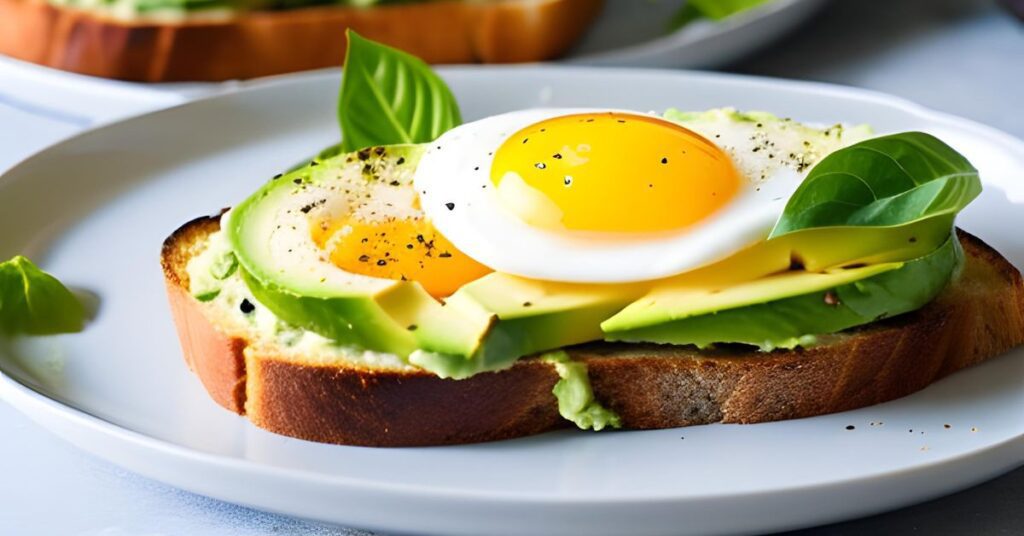
Ingredients:
- 2 slices of whole-grain bread
- 1 ripe avocado
- 2 large eggs
- Salt and pepper to taste
- Optional toppings: red pepper flakes, cherry tomatoes, or microgreens
Instructions:
- Toast the slices of whole-grain bread until they are golden brown and crisp.
- While the bread is toasting, cut the avocado in half, remove the pit, and scoop the flesh into a bowl. Mash the avocado with a fork until you achieve your desired texture.
- In a non-stick skillet over medium heat, fry the eggs to your preferred level of doneness (sunny-side up, over-easy, or scrambled).
- Spread the mashed avocado evenly on each slice of toasted bread.
- Place one cooked egg on top of each slice of bread with avocado.
- Sprinkle with salt and pepper to taste and add any optional toppings you prefer.
- Serve immediately for a delicious and satisfying breakfast.
2. Greek Yogurt Parfait
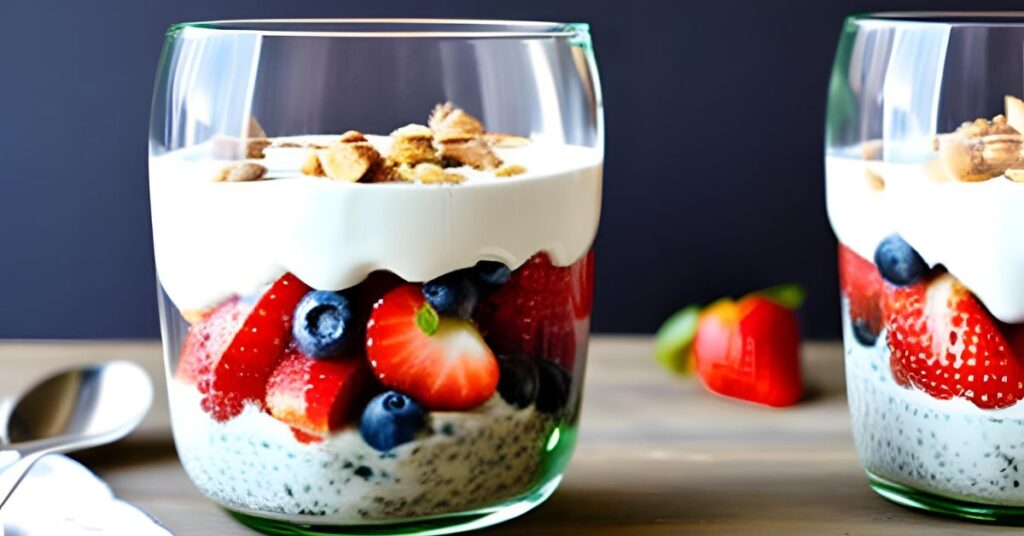
Ingredients:
- 1 cup Greek yogurt (plain or flavored)
- 1/2 cup mixed berries (strawberries, blueberries, raspberries)
- 1/4 cup granola
- 1 tablespoon honey (optional)
Instructions:
- In a glass or a bowl, layer half of the Greek yogurt at the bottom.
- Add half of the mixed berries on top of the yogurt layer.
- Sprinkle half of the granola over the berries.
- Repeat the layers with the remaining yogurt, berries, and granola.
- If desired, drizzle honey over the top for added sweetness.
- Enjoy this refreshing and protein-packed breakfast parfait!
3. Chia Seed Pudding
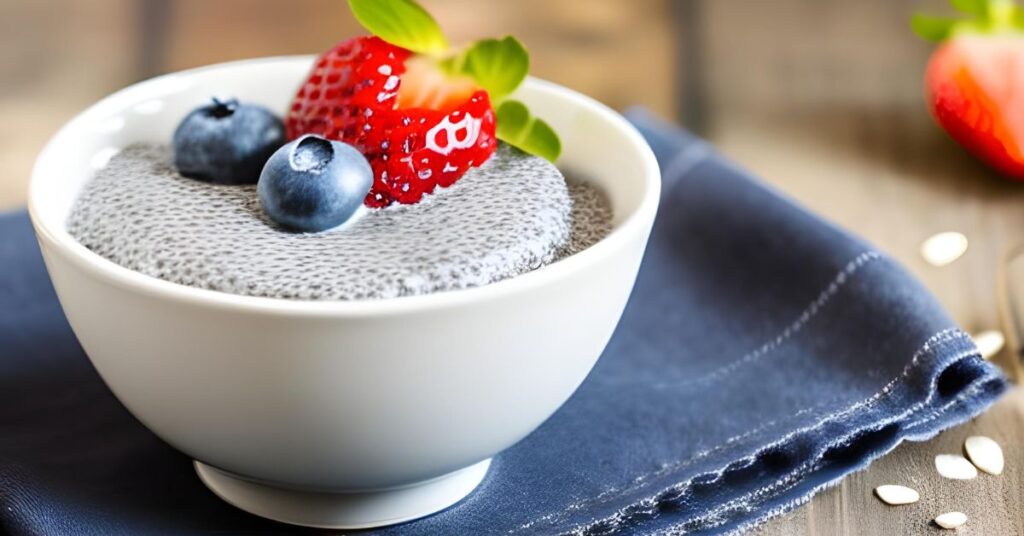
Ingredients:
- 1/4 cup chia seeds
- 1 cup unsweetened almond milk (or any milk of your choice)
- 1 tablespoon maple syrup (adjust to taste)
- 1/2 teaspoon vanilla extract
- Fresh fruits for topping (such as sliced bananas, berries, or mango)
Instructions:
- In a bowl or a jar, mix the chia seeds, almond milk, maple syrup, and vanilla extract.
- Stir well to ensure the chia seeds are evenly distributed and don’t clump together.
- Cover the bowl or jar and refrigerate overnight or for at least 4-6 hours, allowing the chia seeds to absorb the liquid and thicken into a pudding-like consistency.
- Before serving, give the chia seed pudding a good stir to ensure it’s well combined.
- Top with your favorite fresh fruits for added flavor and nutrition.
- Enjoy this nutritious and delightful breakfast pudding.
4. Veggie Omelette
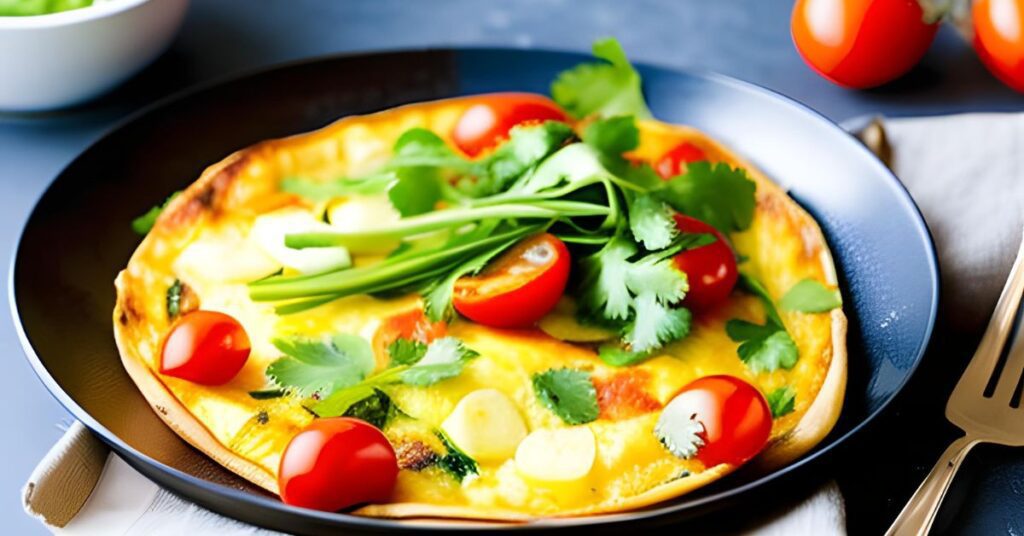
Ingredients:
- 3 large eggs
- 1/4 cup chopped bell peppers (any color)
- 1/4 cup chopped spinach or kale
- 1/4 cup diced tomatoes
- 1/4 cup shredded cheese (cheddar or feta work well)
- Salt and pepper to taste
- 1 tablespoon olive oil or butter for cooking
Instructions:
- In a bowl, whisk the eggs until well beaten. Season with salt and pepper.
- In a non-stick skillet over medium heat, heat the olive oil or butter.
- Add the chopped bell peppers, spinach or kale, and diced tomatoes to the skillet. Cook for 2-3 minutes until the vegetables soften slightly.
- Pour the beaten eggs over the vegetables in the skillet, ensuring they cover the entire surface.
- Sprinkle the shredded cheese evenly over the egg and vegetable mixture.
- Cook the omelet for 3-4 minutes or until the eggs are set and the cheese has melted.
- Carefully fold the omelet in half using a spatula.
- Slide the omelet onto a plate, and it’s ready to serve!
Lunch Ideas
1. Quinoa Salad with Grilled Chicken
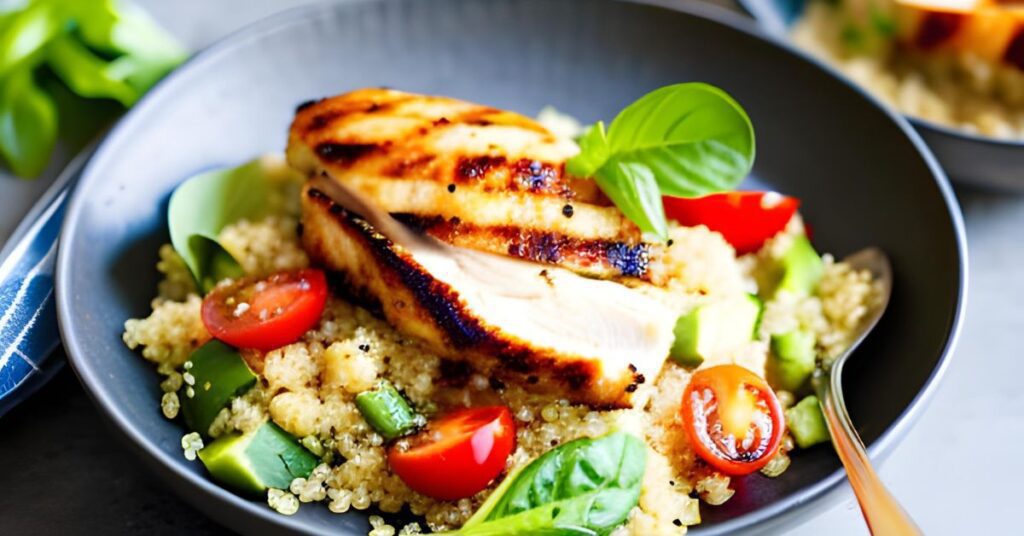
Ingredients:
- 1 cup cooked quinoa
- 4 oz grilled chicken breast, sliced
- 1/2 cup cherry tomatoes, halved
- 1/2 cucumber, diced
- 1/4 cup crumbled feta cheese
- 2 tablespoons chopped fresh parsley
- 2 tablespoons lemon juice
- 2 tablespoons extra-virgin olive oil
- Salt and pepper to taste
Instructions:
- In a large bowl, combine the cooked quinoa, grilled chicken, cherry tomatoes, cucumber, and crumbled feta cheese.
- In a separate small bowl, whisk together the lemon juice, extra-virgin olive oil, salt, and pepper to make the dressing.
- Pour the dressing over the quinoa salad and toss gently to coat all the ingredients evenly.
- Sprinkle chopped fresh parsley over the top for added freshness and flavor.
- Serve this nutritious and protein-packed quinoa salad for a satisfying lunch.
2. Buddha Bowl
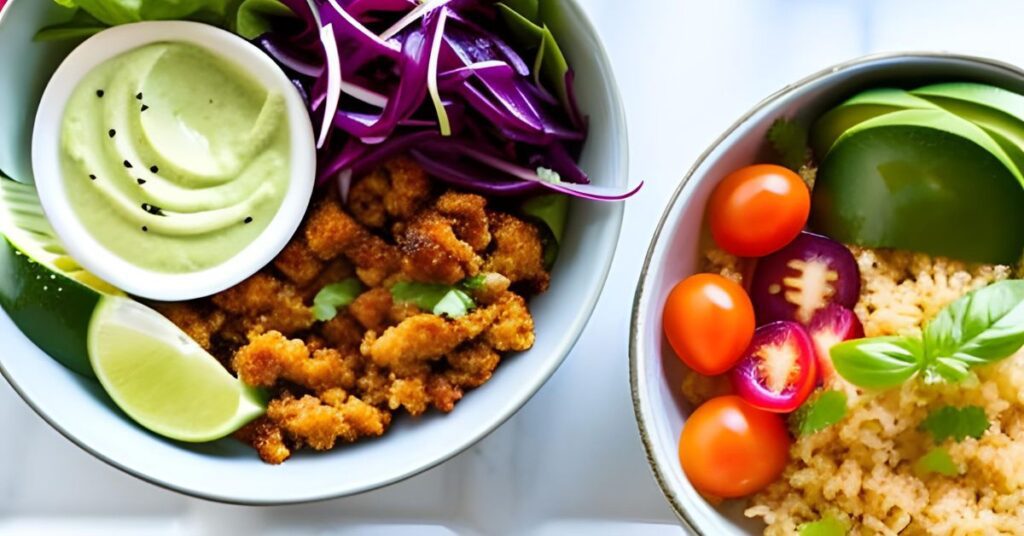
Ingredients:
- 1 cup cooked brown rice or quinoa
- 1/2 cup cooked chickpeas
- 1/2 avocado, sliced
- 1/2 cup shredded carrots
- 1/2 cup steamed broccoli florets
- 2 tablespoons hummus
- 1 tablespoon tahini dressing (optional)
- A sprinkle of sesame seeds or crushed nuts (optional)
Instructions:
- In a bowl, arrange the cooked brown rice or quinoa as the base.
- Add the cooked chickpeas, sliced avocado, shredded carrots, and steamed broccoli on top of the rice/quinoa.
- Drizzle hummus over the bowl for added creaminess and flavor.
- If desired, drizzle tahini dressing over the ingredients for extra nuttiness.
- Sprinkle sesame seeds or crushed nuts on top for a crunchy texture (optional).
- Mix the ingredients before eating or enjoy the flavors separately.
3. Baked Sweet Potato with Black Bean Salsa
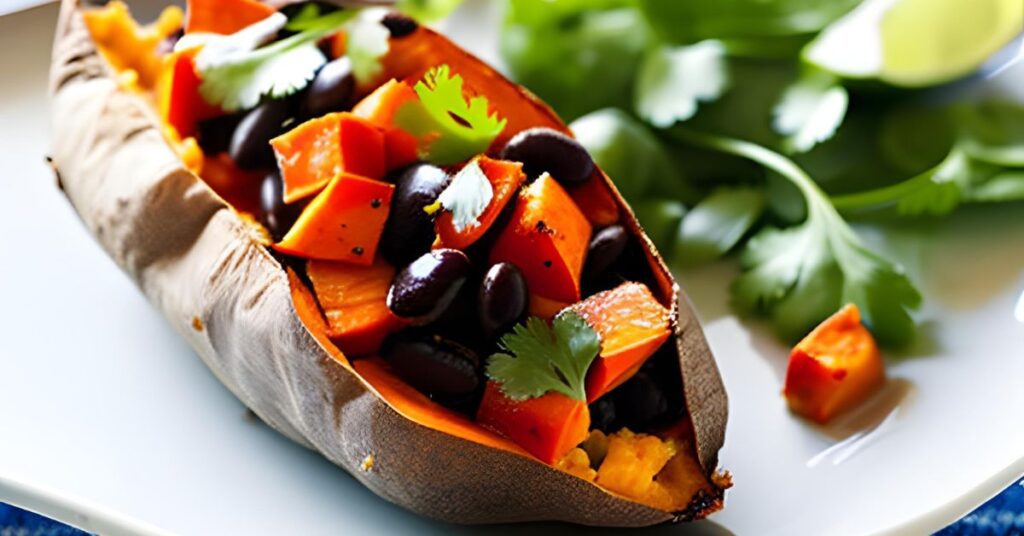
Ingredients:
- 1 medium-sized sweet potato
- 1/2 cup cooked black beans
- 1/4 cup diced red onion
- 1/4 cup diced bell peppers (any color)
- 1/4 cup chopped cilantro
- 1 tablespoon lime juice
- 1 tablespoon olive oil
- Salt and pepper to taste
Instructions:
- Preheat the oven to 400°F (200°C).
- Wash the sweet potato thoroughly and pat it dry. Pierce the sweet potato several times with a fork to allow steam to escape while baking.
- Place the sweet potato on a baking sheet lined with foil or parchment paper.
- Bake the sweet potato for about 45-60 minutes, or until it’s tender when pierced with a fork.
- While the sweet potato is baking, prepare the black bean salsa. In a bowl, combine the cooked black beans, diced red onion, diced bell peppers, chopped cilantro, lime juice, olive oil, salt, and pepper. Mix well.
- Once the sweet potato is done baking, slice it open lengthwise and fill the center with the black bean salsa.
- Serve this flavorful and nutrient-rich baked sweet potato with black bean salsa for a hearty lunch.
4. Mediterranean Chicken Wrap
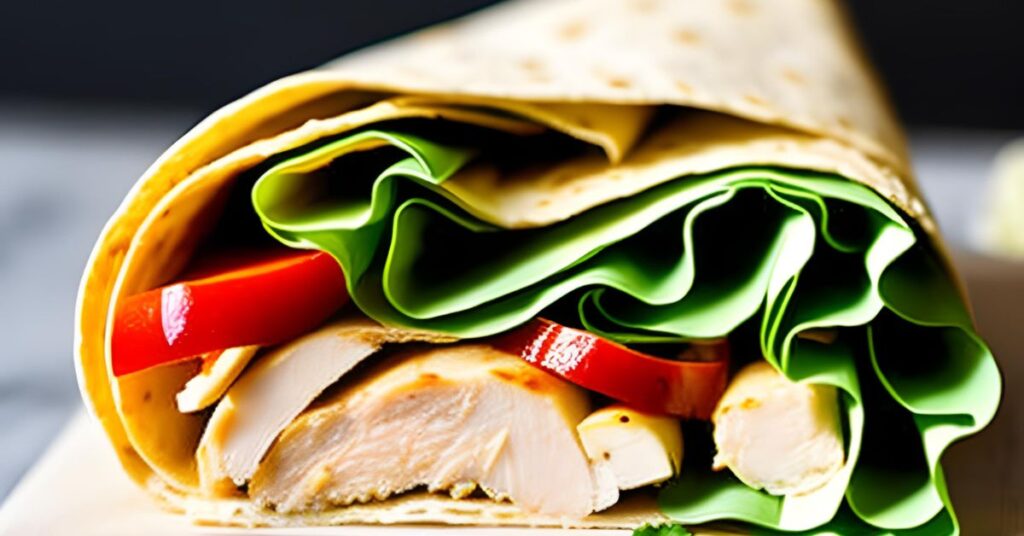
Ingredients:
- 1 whole-grain or whole-wheat tortilla
- 4 oz grilled chicken breast, sliced
- 1/4 cup hummus
- 1/4 cup chopped cucumber
- 1/4 cup diced tomatoes
- 2 tablespoons crumbled feta cheese
- Fresh spinach leaves
- Optional: Kalamata olives, red onion slices
Instructions:
- Lay the whole-grain or whole-wheat tortilla flat on a clean surface.
- Spread hummus evenly over the tortilla, leaving a small border around the edges.
- Layer the sliced grilled chicken, chopped cucumber, diced tomatoes, crumbled feta cheese, and fresh spinach leaves over the hummus.
- If desired, add some Kalamata olives and red onion slices for extra Mediterranean flavors.
- Carefully fold the sides of the tortilla inward, then roll it up tightly from the bottom to form a wrap.
- Slice the wrap in half diagonally for easier handling and serve this delicious and portable Mediterranean chicken wrap for a convenient lunch.
Dinner Ideas
1. Baked Salmon with Roasted Vegetables
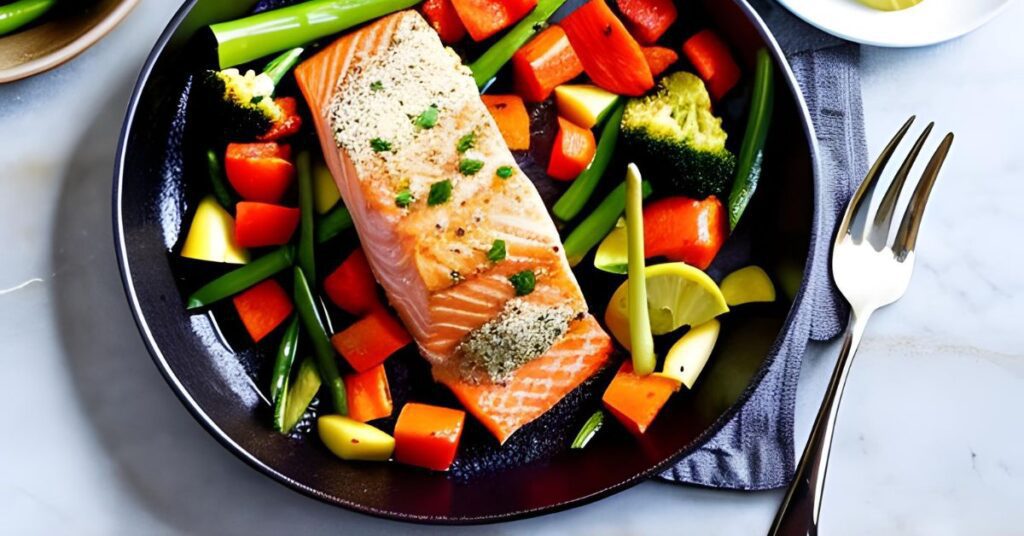
Ingredients:
- 1 salmon fillet (about 6 oz)
- 1 tablespoon olive oil
- 1 teaspoon lemon juice
- 1 teaspoon minced garlic
- Salt and pepper to taste
- 1 cup mixed vegetables (such as broccoli, bell peppers, and cherry tomatoes)
Instructions:
- Preheat the oven to 400°F (200°C).
- In a small bowl, mix olive oil, lemon juice, minced garlic, salt, and pepper.
- Place the salmon fillet on a baking sheet lined with foil or parchment paper.
- Brush the salmon with the olive oil mixture, coating it evenly.
- Arrange the mixed vegetables around the salmon on the baking sheet.
- Drizzle any remaining olive oil mixture over the vegetables.
- Bake in the preheated oven for 15-20 minutes or until the salmon is cooked through and the vegetables are tender.
- Serve this delectable and nutritious baked salmon with roasted vegetables for a delightful dinner.
2. Stir-Fry Tofu and Vegetables
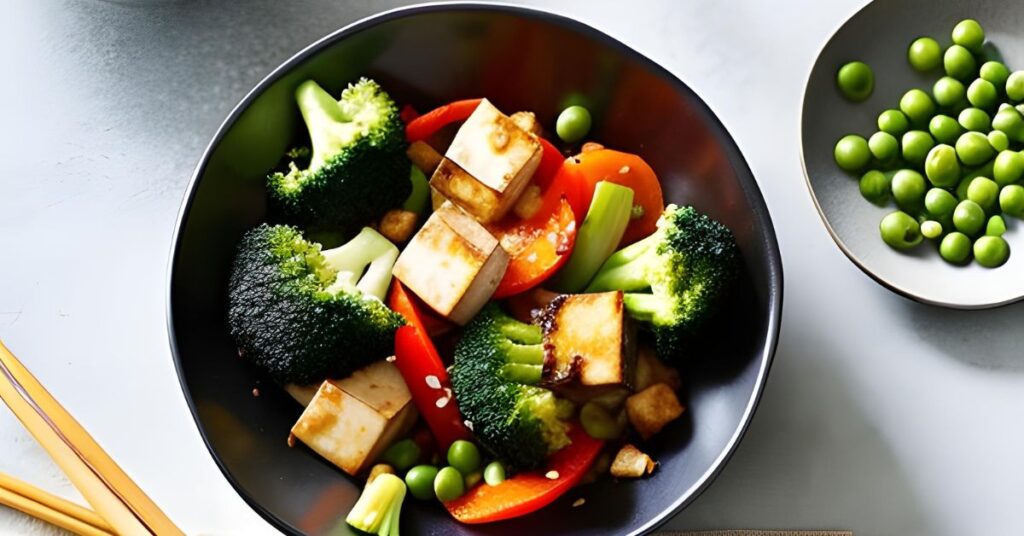
Ingredients:
- 8 oz firm tofu, cubed
- 2 cups mixed vegetables (broccoli, bell peppers, carrots, snap peas)
- 2 tablespoons soy sauce
- 1 tablespoon sesame oil
- 1 teaspoon grated ginger
- 2 cloves garlic, minced
- 1 tablespoon sesame seeds (optional)
- Green onions, chopped (for garnish)
Instructions:
- In a large non-stick skillet or wok, heat the sesame oil over medium-high heat.
- Add the cubed tofu to the skillet and stir-fry until it turns golden and slightly crispy on all sides. Remove the tofu from the skillet and set aside.
- In the same skillet, add the mixed vegetables and stir-fry for 3-4 minutes until they are tender-crisp.
- Reduce the heat to low and add the soy sauce, grated ginger, and minced garlic to the vegetables. Stir to combine.
- Return the cooked tofu to the skillet and toss everything together until the tofu and vegetables are coated with the sauce.
- If desired, sprinkle sesame seeds over the stir-fry for added texture and nuttiness.
- Serve this flavorful and protein-rich tofu and vegetable stir-fry over a bed of brown rice or quinoa for a satisfying dinner.
3. Grilled Chicken and Veggie Skewers
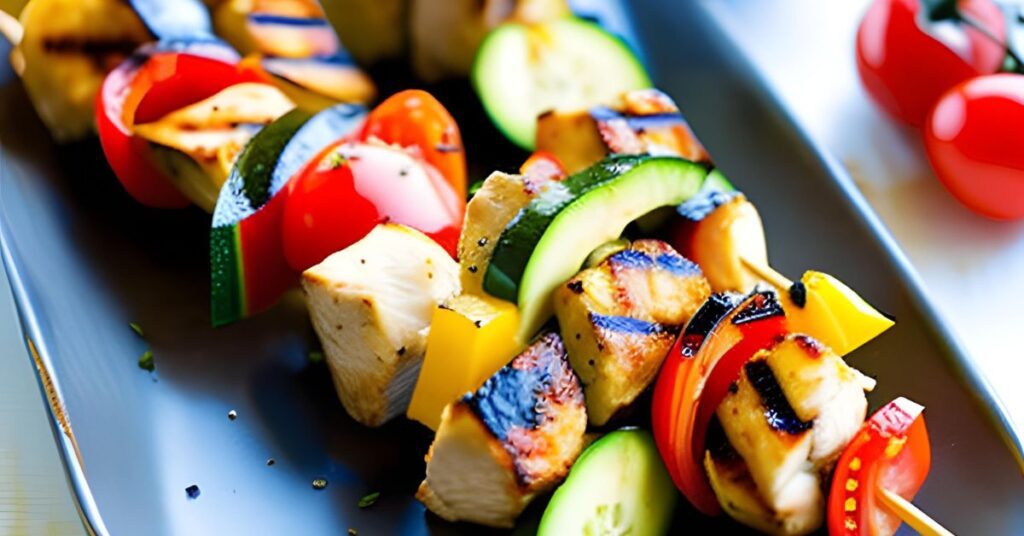
Ingredients:
- 8 oz (about 236.59 ml) chicken breast, cut into cubes
- 1 zucchini, sliced
- 1 bell pepper (any color), cut into chunks
- 1 red onion, cut into chunks
- 1 tablespoon olive oil
- 1 teaspoon dried oregano
- 1/2 teaspoon garlic powder
- Salt and pepper to taste
- Wooden or metal skewers
Instructions:
- Preheat the grill or grill pan over medium-high heat.
- In a bowl, toss the chicken cubes, zucchini slices, bell pepper chunks, and red onion chunks with olive oil, dried oregano, garlic powder, salt, and pepper.
- Thread the marinated chicken and vegetables onto the skewers, alternating between ingredients.
- Grill the skewers for about 10-12 minutes, turning occasionally, until the chicken is cooked through, and the vegetables are slightly charred.
- Remove the skewers from the grill and serve these delicious and colorful grilled chicken and veggie skewers for a healthy dinner.
4. Lentil and Vegetable Curry
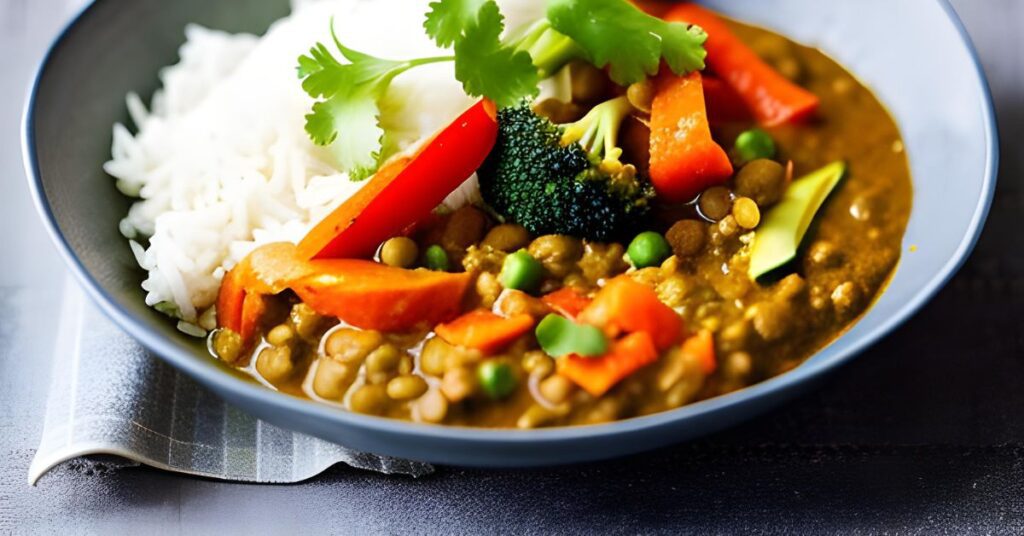
Ingredients:
- 1 cup dried lentils (red or green), rinsed
- 1 tablespoon olive oil
- 1 onion, finely chopped
- 2 cloves garlic, minced
- 1 tablespoon curry powder
- 1 teaspoon ground cumin
- 1 teaspoon ground coriander
- 1/2 teaspoon turmeric powder
- 1 can (14 oz) diced tomatoes
- 1 can (14 oz) coconut milk
- 2 cups mixed vegetables (carrots, bell peppers, peas)
- Salt and pepper to taste
- Fresh cilantro, chopped (for garnish)
- Cooked brown rice (optional, for serving)
Instructions:
- In a large pot or saucepan, heat the olive oil over medium heat.
- Add the chopped onion and sauté until it becomes translucent.
- Stir in the minced garlic, curry powder, ground cumin, ground coriander, and turmeric powder. Cook for a minute until fragrant.
- Add the rinsed lentils to the pot and stir to coat them with the spices.
- Pour in the diced tomatoes and coconut milk and bring the mixture to a boil.
- Reduce the heat to low, cover the pot, and let it simmer for about 20-25 minutes or until the lentils are tender.
- Stir in the mixed vegetables and cook for an additional 5 minutes until they are cooked through but still crisp.
- Season with salt and pepper to taste.
- Serve this hearty and flavorful lentil and vegetable curry over cooked brown rice for a satisfying and nutritious dinner.
Snack Ideas
1. Greek Yogurt with Berries and Honey
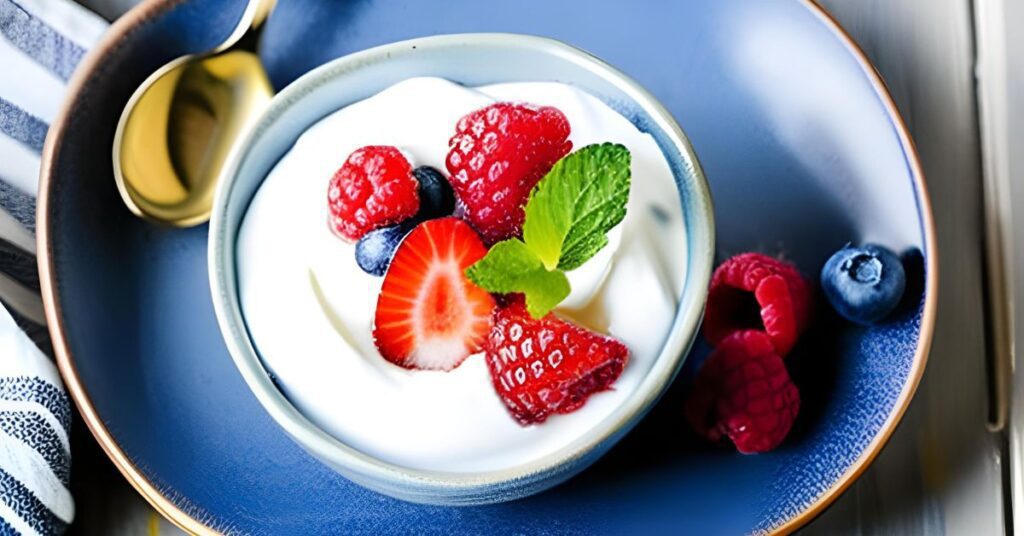
Ingredients:
- 1/2 cup Greek yogurt (plain or flavored)
- 1/4 cup mixed berries (strawberries, blueberries, raspberries)
- 1 tablespoon honey (adjust to taste)
Instructions:
- In a bowl, scoop the Greek yogurt.
- Top the yogurt with the mixed berries.
- Drizzle honey over the berries and yogurt for natural sweetness.
- Mix the ingredients for a creamy and delicious snack.
2. Nut Butter and Banana Rice Cakes
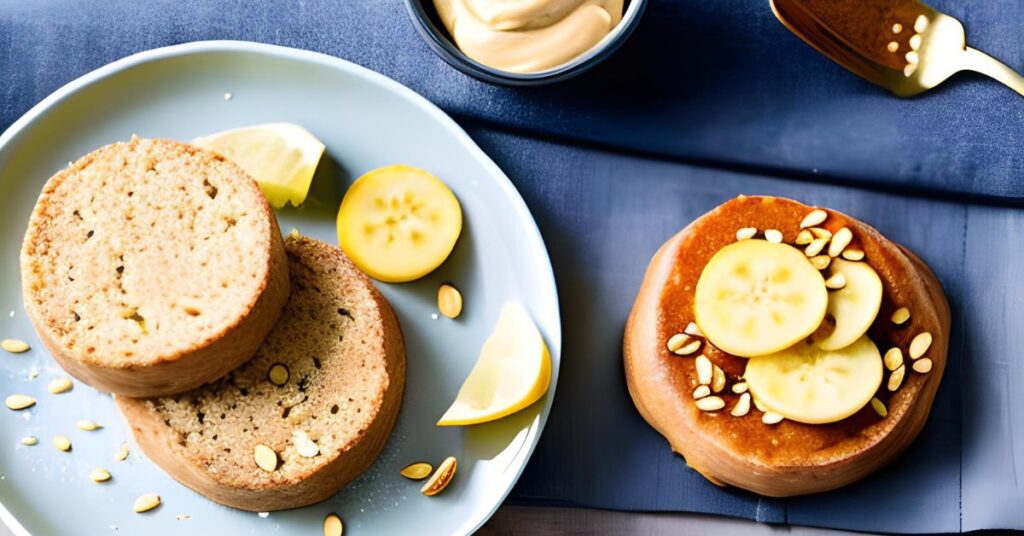
Ingredients:
- 2 rice cakes
- 2 tablespoons nut butter (almond, peanut, or cashew)
- 1 banana, sliced
Instructions:
- Spread nut butter evenly on each rice cake.
- Top the rice cakes with banana slices.
- Press the two rice cakes together to make a tasty and crunchy sandwich.
- Enjoy this quick and satisfying snack.
3. Hummus and Veggie Sticks
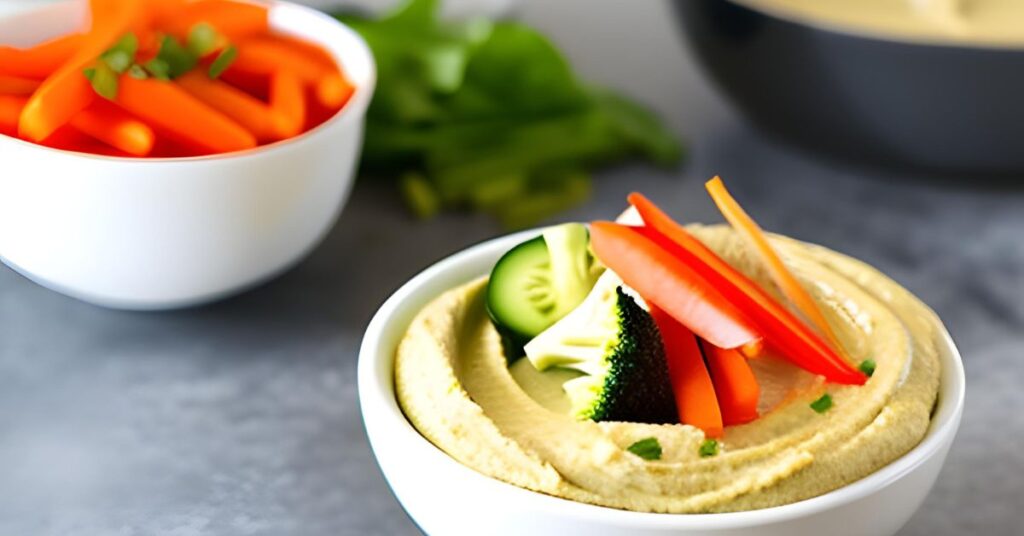
Ingredients:
- 1/4 cup hummus (store-bought or homemade)
- Assorted vegetable sticks (carrots, cucumber, bell peppers)
Instructions:
- Pour the hummus into a small bowl.
- Cut the vegetables into sticks for easy dipping.
- Dip the vegetable sticks into the hummus and enjoy this refreshing and nutritious snack.
4. Energy Bites
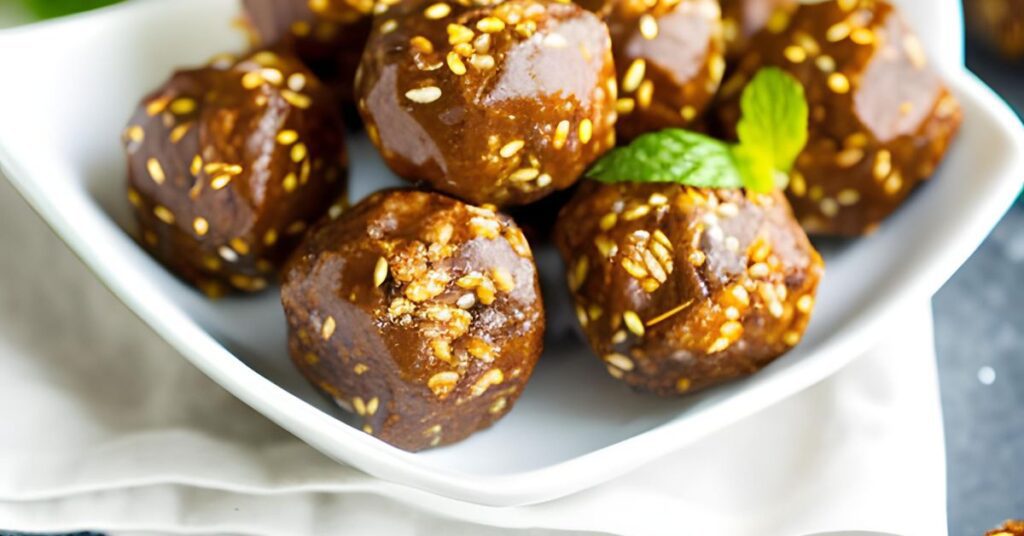
Ingredients:
- 1 cup old-fashioned rolled oats
- 1/2 cup nut butter (almond, peanut, or cashew)
- 1/4 cup honey or maple syrup
- 1/4 cup ground flaxseed
- 1/4 cup mini chocolate chips (optional)
- 1 teaspoon vanilla extract
- Pinch of salt
Instructions:
- In a large bowl, mix nut butter, honey or maple syrup, and vanilla extract until well combined.
- Add rolled oats, ground flaxseed, chocolate chips (if using), and a pinch of salt to the bowl. Stir until all the ingredients are evenly incorporated.
- Cover the bowl and refrigerate the mixture for about 20-30 minutes to make it easier to handle.
- Once chilled, use your hands to roll the mixture into small bite-sized balls.
- Place the energy bites on a plate or a baking sheet lined with parchment paper.
- Refrigerate the energy bites for another 10-15 minutes to set.
- Store the energy bites in an airtight container in the refrigerator for quick and convenient snacking.
Different Methods of Intermittent Fasting meal ideas
Method 1 : 18/6
Breakfast Ideas:
1. Berry Chia Seed Pudding

Ingredients:
- 1/4 cup chia seeds
- 1 cup unsweetened almond milk (or any milk of your choice)
- 1 tablespoon maple syrup (adjust to taste)
- 1/2 teaspoon vanilla extract
- 1/2 cup mixed berries (strawberries, blueberries, raspberries)
Instructions:
- In a bowl or jar, mix chia seeds, almond milk, maple syrup, and vanilla extract.
- Stir well and refrigerate overnight or for at least 4-6 hours to thicken.
- Before serving, layer the chia seed pudding with mixed berries in a glass or bowl.
- Enjoy this nutrient-rich and delicious breakfast.
2. Avocado and Egg Cups
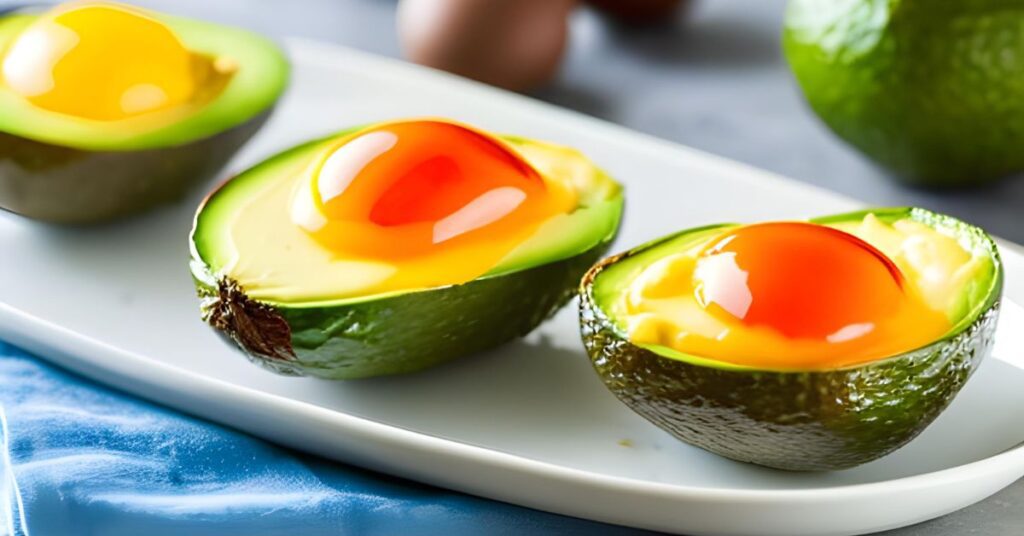
Ingredients:
- 2 ripe avocados
- 4 large eggs
- Salt and pepper to taste
- Optional toppings: diced tomatoes, chopped cilantro, or hot sauce
Instructions:
- Preheat the oven to 375°F (190°C).
- Cut the avocados in half and remove the pits.
- Scoop out a bit of flesh from each avocado in half to create a larger space for the egg.
- Place the avocado halves in a baking dish.
- Crack an egg into each avocado half.
- Sprinkle salt and pepper on top.
- Bake in the preheated oven for 15-20 minutes or until the eggs are cooked to your liking.
- Add optional toppings if desired and serve these tasty and filling avocado and egg cups.
Lunch Ideas:
3. Grilled Chicken Salad
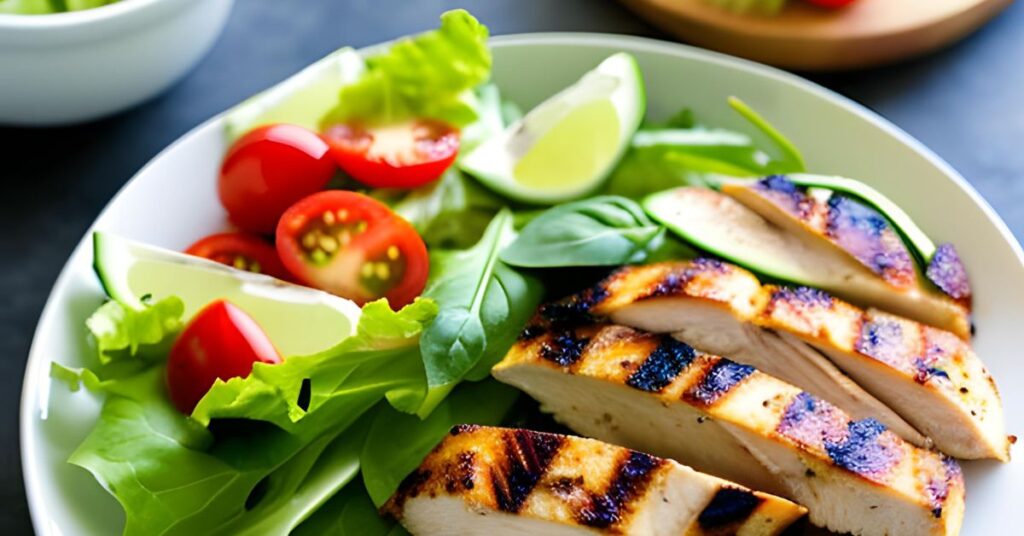
Ingredients:
- 4 oz (about 118.29 ml) grilled chicken breast, sliced
- Mixed greens (spinach, arugula, lettuce)
- Cherry tomatoes, halved
- Cucumber slices
- Red onion, thinly sliced
- Balsamic vinaigrette dressing
Instructions:
- In a large bowl, toss the mixed greens with cherry tomatoes, cucumber slices, and red onion.
- Add the sliced grilled chicken on top of the salad.
- Drizzle with balsamic vinaigrette dressing.
- Toss the ingredients together to coat them with the dressing.
- Enjoy this light and nutritious grilled chicken salad.
4. Quinoa Buddha Bowl

Ingredients:
- 1 cup cooked quinoa
- 1/2 cup cooked black beans
- Roasted sweet potatoes, cubed
- Sautéed kale or spinach
- Avocado slices
- Tahini dressing
Instructions:
- In a bowl, layer the cooked quinoa, black beans, roasted sweet potatoes, and sautéed kale or spinach.
- Add avocado slices for creaminess.
- Drizzle with tahini dressing for added flavor.
- Toss the ingredients together for a wholesome and satisfying quinoa Buddha bowl.
Dinner Ideas:
5. Baked Salmon with Asparagus
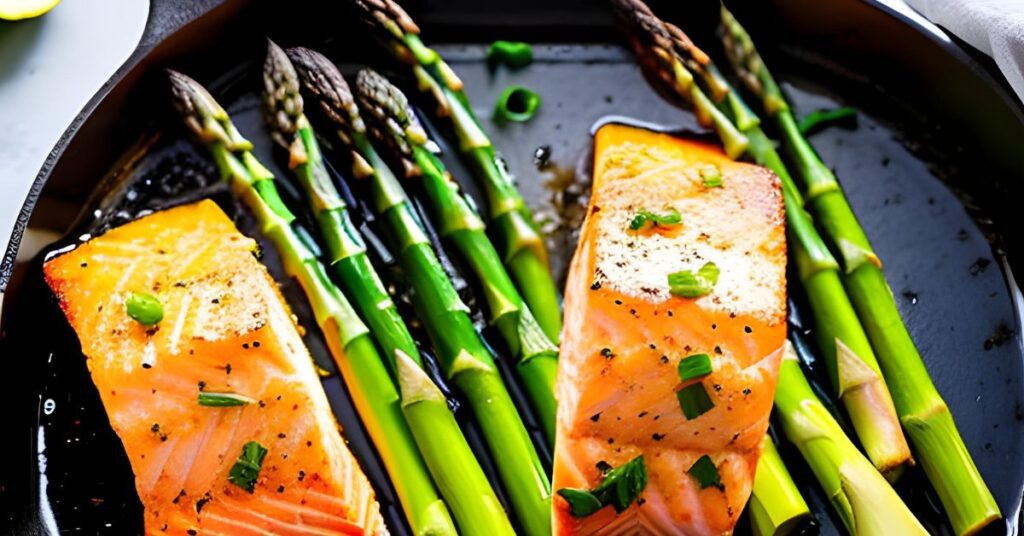
Ingredients:
- 1 salmon fillet
- 1 bunch of asparagus
- 1 tablespoon olive oil
- Lemon slices
- Fresh dill or parsley (optional)
- Salt and pepper to taste
Instructions:
- Preheat the oven to 400°F (200°C).
- Place the salmon fillet on a baking sheet lined with foil or parchment paper.
- Arrange the asparagus around the salmon.
- Drizzle olive oil over the salmon and asparagus.
- Season with salt and pepper and add lemon slices on top of the salmon.
- Bake in the preheated oven for 15-20 minutes or until the salmon is cooked through and the asparagus is tender.
- Garnish with fresh dill or parsley if desired.
- Serve this flavorful and nutritious baked salmon with asparagus for a delightful dinner.
6. Stir-Fry Tofu and Vegetables

Ingredients:
- 8 oz (about 236.59 ml) firm tofu, cubed
- 2 cups mixed vegetables (broccoli, bell peppers, carrots, snap peas)
- 2 tablespoons soy sauce
- 1 tablespoon sesame oil
- 1 teaspoon grated ginger
- 2 cloves garlic, minced
- 1 tablespoon sesame seeds (optional)
- Green onions, chopped (for garnish)
Instructions:
- In a large non-stick skillet or wok, heat the sesame oil over medium-high heat.
- Add the cubed tofu to the skillet and stir-fry until it turns golden and slightly crispy on all sides. Remove the tofu from the skillet and set aside.
- In the same skillet, add the mixed vegetables and stir-fry for 3-4 minutes until they are tender-crisp.
- Reduce the heat to low and add the soy sauce, grated ginger, and minced garlic to the vegetables. Stir to combine.
- Return the cooked tofu to the skillet and toss everything together until the tofu and vegetables are coated with the sauce.
- If desired, sprinkle sesame seeds over the stir-fry for added texture and nuttiness.
- Serve this flavorful and protein-rich tofu and vegetable stir-fry over a bed of brown rice or quinoa for a satisfying dinner.
7. Zucchini Noodles with Pesto and Cherry Tomatoes
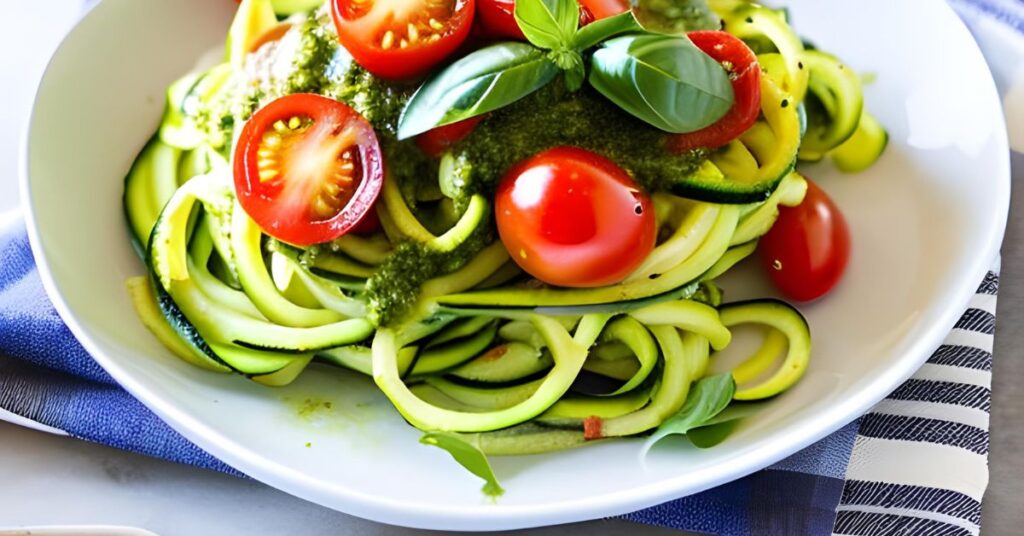
Ingredients:
- 2 medium zucchinis, spiralized or thinly sliced
- 1 cup cherry tomatoes, halved
- 2 tablespoons homemade or store-bought pesto sauce
- Grated Parmesan cheese (optional)
- Fresh basil leaves (for garnish)
Instructions:
- In a large skillet over medium heat, sauté the zucchini noodles until they are slightly softened but still al dente.
- Add the halved cherry tomatoes to the skillet and toss with the zucchini noodles.
- Stir in the pesto sauce until the noodles and tomatoes are coated evenly.
- If desired, sprinkle grated Parmesan cheese over the dish.
- Garnish with fresh basil leaves for added aroma and taste.
- Serve this light and flavorful zucchini noodle dish for a satisfying dinner.
Method 2 : 20/4
Breakfast Ideas:
1. Spinach and Mushroom Omelette
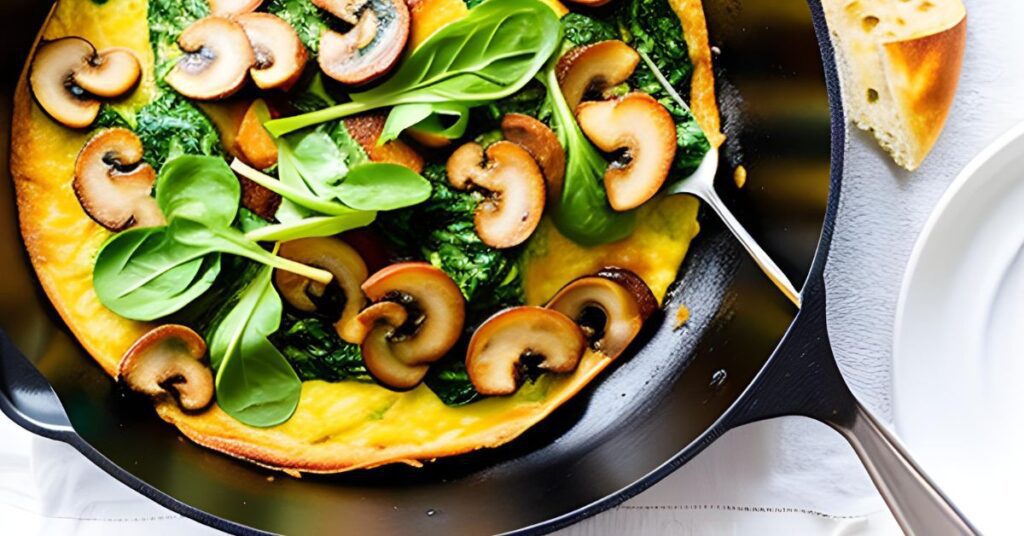
Ingredients:
- 3 large eggs
- 1 cup baby spinach
- 1/2 cup sliced mushrooms
- 1/4 cup diced onions
- 1/4 cup shredded cheddar cheese
- Salt and pepper to taste
- 1 tablespoon olive oil
Instructions:
- In a bowl, whisk the eggs until well beaten. Season with salt and pepper.
- In a non-stick skillet over medium heat, heat the olive oil.
- Add the diced onions and sliced mushrooms, and sauté until softened.
- Add the baby spinach to the skillet and cook until wilted.
- Pour the beaten eggs over the vegetables in the skillet, ensuring they cover the entire surface.
- Sprinkle shredded cheddar cheese over the egg and vegetable mixture.
- Cook the omelet for 3-4 minutes or until the eggs are set and the cheese has melted.
- Carefully fold the omelet in half using a spatula.
- Slide the omelet onto a plate, and it’s ready to serve!
2. Smoothie Bowl
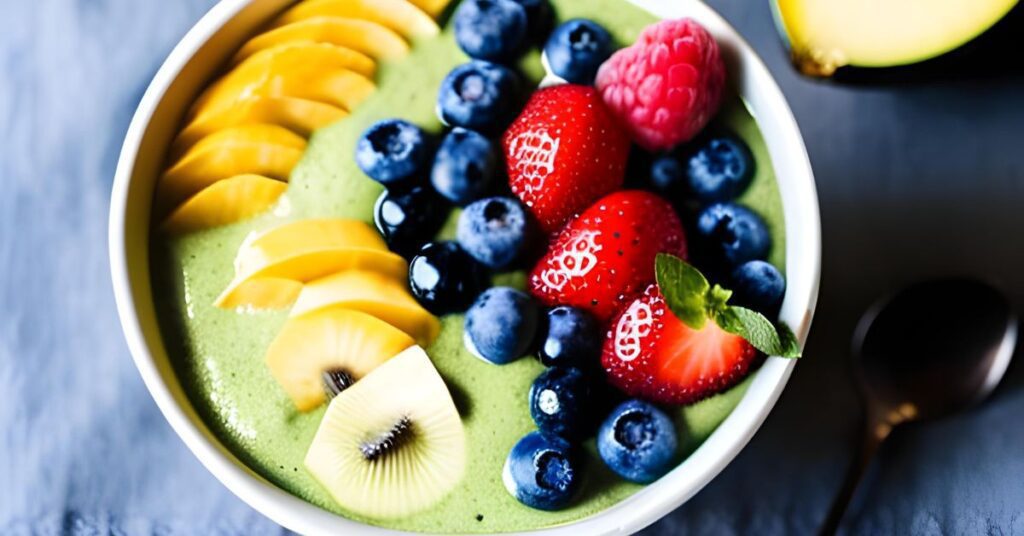
Ingredients:
- 1 cup frozen mixed berries (strawberries, blueberries, raspberries)
- 1 ripe banana
- 1/2 cup unsweetened almond milk (or any milk of your choice)
- 2 tablespoons Greek yogurt (plain or flavored)
- Toppings: sliced fresh fruits, granola, chia seeds, nuts, coconut flakes
Instructions:
- In a blender, combine the frozen mixed berries, ripe banana, almond milk, and Greek yogurt.
- Blend until smooth and creamy, adding more liquid if needed to achieve the desired consistency.
- Pour the smoothie into a bowl.
- Top with sliced fresh fruits, granola, chia seeds, nuts, and coconut flakes for added texture and nutrition.
- Enjoy this colorful and refreshing smoothie bowl for a nutritious breakfast.
Lunch Ideas:
3. Grilled Shrimp and Avocado Salad
Ingredients:
- 6 oz (about 177.44 ml) grilled shrimp
- Mixed greens (spinach, arugula, lettuce)
- Cherry tomatoes, halved
- Avocado slices
- Cucumber slices
- Balsamic vinaigrette dressing
Instructions:
- In a large bowl, toss the mixed greens with cherry tomatoes, avocado slices, and cucumber slices.
- Add the grilled shrimp on top of the salad.
- Drizzle with balsamic vinaigrette dressing.
- Toss the ingredients together to coat them with the dressing.
- Enjoy this light and nutritious grilled shrimp and avocado salad.
4. Chicken Lettuce Wraps
Ingredients:
- 8 oz (about 236.59 ml) ground chicken
- 1 tablespoon olive oil
- 2 cloves garlic, minced
- 1/4 cup hoisin sauce
- 2 tablespoons soy sauce
- 1 tablespoon rice vinegar
- 1 teaspoon grated ginger
- 1/4 cup sliced green onions
- Iceberg lettuce leaves (or any lettuce of your choice)
- Optional toppings: chopped peanuts, cilantro, and lime wedges
Instructions:
- In a large skillet over medium heat, heat the olive oil.
- Add the minced garlic and grated ginger, and sauté until fragrant.
- Add the ground chicken to the skillet and cook until it’s browned and cooked through.
- Stir in the hoisin sauce, soy sauce, and rice vinegar. Cook for another minute to combine the flavors.
- Add sliced green onions and toss to incorporate.
- To serve, spoon the chicken mixture onto the lettuce leaves.
- Top with optional toppings like chopped peanuts, cilantro, and a squeeze of lime juice.
- Roll up the lettuce leaves to create delicious and low-carb chicken lettuce wraps.
Dinner Ideas:
5. Baked Cod with Roasted Vegetables
Ingredients:
- 6 oz (about 177.44 ml) cod fillet
- 1 tablespoon olive oil
- 1 tablespoon lemon juice
- 1 teaspoon minced garlic
- Salt and pepper to taste
- 1 cup mixed vegetables (such as broccoli, bell peppers, and cherry tomatoes)
Instructions:
- Preheat the oven to 400°F (200°C).
- Place the cod fillet on a baking sheet lined with foil or parchment paper.
- In a small bowl, mix olive oil, lemon juice, minced garlic, salt, and pepper.
- Brush the cod fillet with the olive oil mixture, coating it evenly.
- Arrange the mixed vegetables around the cod on the baking sheet.
- Drizzle any remaining olive oil mixture over the vegetables.
- Bake in the preheated oven for 15-20 minutes or until the cod is cooked through and the vegetables are tender.
- Serve this delectable and nutritious baked cod with roasted vegetables for a delightful dinner.
6. Veggie Stir-Fry with Tofu
Ingredients:
- 8 oz (about 236.59 ml) firm tofu, cubed
- 2 cups mixed vegetables (broccoli, bell peppers, carrots, snap peas)
- 2 tablespoons soy sauce
- 1 tablespoon sesame oil
- 1 teaspoon grated ginger
- 2 cloves garlic, minced
- 1 tablespoon sesame seeds (optional)
- Green onions, chopped (for garnish)
Instructions:
- In a large non-stick skillet or wok, heat the sesame oil over medium-high heat.
- Add the cubed tofu to the skillet and stir-fry until it turns golden and slightly crispy on all sides. Remove the tofu from the skillet and set aside.
- In the same skillet, add the mixed vegetables and stir-fry for 3-4 minutes until they are tender-crisp.
- Reduce the heat to low and add the soy sauce, grated ginger, and minced garlic to the vegetables. Stir to combine.
- Return the cooked tofu to the skillet and toss everything together until the tofu and vegetables are coated with the sauce.
- If desired, sprinkle sesame seeds over the stir-fry for added texture and nuttiness.
- Serve this flavorful and protein-rich tofu and vegetable stir-fry over a bed of brown rice or quinoa for a satisfying dinner.
Method 3 : 16/2
Breakfast Ideas:
1. Overnight Oats
Ingredients:
- 1/2 cup rolled oats
- 1 cup unsweetened almond milk (or any milk of your choice)
- 1 tablespoon chia seeds
- 1/2 teaspoon vanilla extract
- 1 tablespoon honey or maple syrup
- Sliced fruits (bananas, berries) and nuts for topping
Instructions:
- In a jar or airtight container, combine rolled oats, almond milk, chia seeds, vanilla extract, and honey or maple syrup.
- Stir well and refrigerate overnight or for at least 4 hours to allow the oats to absorb the liquid and thicken.
- Before serving, stir the oats a good stir and top with sliced fruits and nuts for added flavor and texture.
- Enjoy this creamy and nutritious overnight oat for a quick and easy breakfast.
2. Veggie and Cheese Frittata
Ingredients:
- 4 large eggs
- 1/4 cup milk
- 1/2 cup diced bell peppers (any color)
- 1/2 cup diced tomatoes
- 1/4 cup chopped spinach or kale
- 1/4 cup shredded cheddar cheese (or any cheese of your choice)
- Salt and pepper to taste
- 1 tablespoon olive oil
Instructions:
- Preheat the oven to 350°F (175°C).
- In a bowl, whisk the eggs and milk until well combined. Season with salt and pepper.
- In a non-stick skillet over medium heat, heat the olive oil.
- Add the diced bell peppers and cook for a few minutes until they start to soften.
- Add the diced tomatoes and chopped spinach or kale to the skillet and sauté until the vegetables are cooked.
- Pour the egg mixture over the sautéed vegetables in the skillet.
- Sprinkle shredded cheddar cheese evenly over the eggs and vegetables.
- Transfer the skillet to the preheated oven and bake for about 12-15 minutes or until the frittata is set and slightly puffed.
- Remove the skillet from the oven, let it cool for a minute, then slice and serve this delicious and protein-packed veggie and cheese frittata.
Lunch Ideas:
3. Grilled Chicken Salad with Avocado Dressing
Ingredients:
- 4 oz (about 118.29 ml) grilled chicken breast, sliced
- Mixed greens (spinach, arugula, lettuce)
- Cherry tomatoes, halved
- Cucumber slices
- Red onion, thinly sliced
Avocado Dressing:
- 1 ripe avocado
- 1/4 cup Greek yogurt (plain or flavored)
- 1/4 cup water
- 2 tablespoons lime juice
- 1 tablespoon chopped cilantro
- Salt and pepper to taste
Instructions:
- In a blender or food processor, combine the flesh of the avocado, Greek yogurt, water, lime juice, chopped cilantro, salt, and pepper.
- Blend until smooth and creamy, adding more water if needed to reach your desired consistency.
- In a large bowl, toss the mixed greens with cherry tomatoes, cucumber slices, and red onion.
- Add the sliced grilled chicken on top of the salad.
- Drizzle the avocado dressing over the salad.
- Toss the ingredients together to coat them with the dressing.
- Enjoy this refreshing and satisfying grilled chicken salad with avocado dressing.
4. Quinoa Stuffed Bell Peppers
Ingredients:
- 1 cup cooked quinoa
- 2 large bell peppers (any color)
- 1/2 cup cooked black beans
- 1/2 cup diced tomatoes
- 1/4 cup diced red onion
- 1/4 cup diced zucchini
- 1/4 cup shredded cheddar cheese (optional)
- 1 teaspoon olive oil
- 1/2 teaspoon ground cumin
- 1/2 teaspoon chili powder
- Salt and pepper to taste
Instructions:
- Preheat the oven to 375°F (190°C).
- Cut the tops off the bell peppers and remove the seeds and membranes from the inside.
- In a large skillet over medium heat, heat the olive oil.
- Add the diced red onion and sauté until it becomes translucent.
- Add the diced zucchini to the skillet and cook for a few minutes until it softens.
- Stir in the cooked black beans, diced tomatoes, ground cumin, chili powder, salt, and pepper. Cook for another minute to combine the flavors.
- Remove the skillet from heat and add the cooked quinoa to the mixture. Stir until everything is well combined.
- Carefully stuff the bell peppers with the quinoa and vegetable mixture.
- If using shredded cheddar cheese, sprinkle it over the stuffed bell peppers.
- Place the stuffed bell peppers in a baking dish and bake in the preheated oven for about 25-30 minutes or until the peppers are tender and the cheese (if used) is melted and bubbly.
- Remove the stuffed bell peppers from the oven, let them cool for a minute, and serve this flavorful and nutrient-packed quinoa stuffed bell peppers.
Dinner Ideas:
5. Baked Salmon with Lemon and Dill
Ingredients:
- 6 oz (about 177.44 ml) salmon fillet
- 1 tablespoon olive oil
- 1 tablespoon lemon juice
- 1 teaspoon dried dill
- Salt and pepper to taste
- Lemon slices (for garnish)
- Fresh dill (for garnish)
Instructions:
- Preheat the oven to 400°F (200°C).
- Place the salmon fillet on a baking sheet lined with foil or parchment paper.
- In a small bowl, mix olive oil, lemon juice, dried dill, salt, and pepper.
- Brush the salmon fillet with the olive oil mixture, coating it evenly.
- Place lemon slices on top of the salmon for added flavor and aroma.
- Bake in the preheated oven for 12-15 minutes or until the salmon is cooked through and flakes easily with a fork.
- Garnish with fresh dill before serving this delicious and healthy baked salmon.
6. Grilled Vegetable and Quinoa Bowl
Ingredients:
- 1 cup cooked quinoa
- 1 zucchini, sliced lengthwise
- 1 red bell pepper, sliced
- 1 yellow bell pepper, sliced
- 1/2 red onion, sliced
- 1 tablespoon olive oil
- 1 teaspoon dried oregano
- 1/2 teaspoon garlic powder
- Salt and pepper to taste
- Lemon wedges (for serving)
- Fresh parsley (for garnish)
Instructions:
- Preheat the grill or grill pan over medium-high heat.
- In a bowl, toss the sliced zucchini, red bell pepper, yellow bell pepper, and red onion with olive oil, dried oregano, garlic powder, salt, and pepper.
- Grill the vegetables for about 4-5 minutes per side or until they have grill marks and are tender.
- In a serving bowl, layer the cooked quinoa and grilled vegetables.
- Squeeze fresh lemon juice over the bowl for added zest.
- Garnish with fresh parsley and serve this nutritious and flavorful grilled vegetable and quinoa bowl.
Conclusion
Incorporating intermittent fasting into your lifestyle can bring about numerous health benefits and promote overall well-being.
By following these diverse and nutritious meal ideas, you can make the most of your eating window and keep your energy levels high throughout the day.
Whether you’re looking for satisfying breakfasts, wholesome lunches, or delightful dinners, these recipes offer a perfect balance of flavors and nutrients to support your intermittent fasting journey.
Remember to listen to your body and choose meals that align with your dietary preferences and health goals. With a mindful approach to intermittent fasting and a wide array of delicious meal options, you can enjoy a healthier and more vibrant life. Bon appétit!

